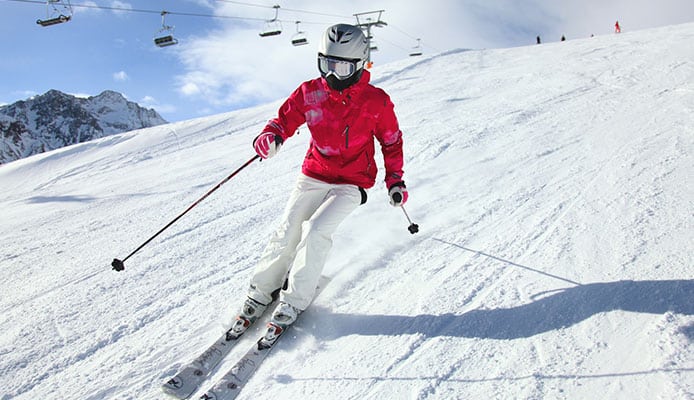
Skiing is a fantastic activity for both body and mind, and a winter favorite for many of us. To get the most out of the time you spend on the snow, you need a good pair of skis. For a long time, women and men have used the same skis, which was not optimal for female skiers. Manufacturers have recognized this problem and nowadays the best women’s skis are perfectly tailored for female users. Of course, we’re not talking about cosmetics here, but rather actual construction differences.
Compared to men, women have a different physique, stance, center of gravity, and movement. To get the ski to perform how you want, it needs to adapt to this by adjusting length, weight, flexibility, and a few other things. Our buying guide will explain all of this and help you select a great new pair of skis. But first, check out our women’s skis reviews with three models that have really impressed us and gained quite a reputation among female skiers.
OUR TOP PICK
Blizzard Black Pearl 88
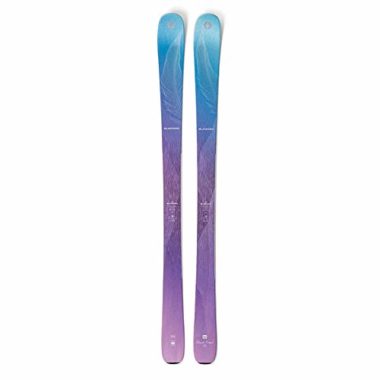
- Stand Out Features - Why We Love It
- Carbon Flipcore women-specific design
- Camber underfoot with early rise tip and tail
- Sandwich compound sidewall construction
- Carbon frame helps dampen impacts
- Great all-around performer
- Excellent for advanced skiers
Length: 166cm
Width (Tip/Waist/Tail): 126/88/110mm
Profile: Camber with Tip and Tail Rocker
Sidecut Radius: 13m @ 159cm
Weight: 5.95lbs (pair)
Bindings: No
Core: Poplar/Beechwood core
Skill Level: Advanced Intermediate
Type: All-mountain
EDITORS CHOICE
Alpina Control 60 Cross
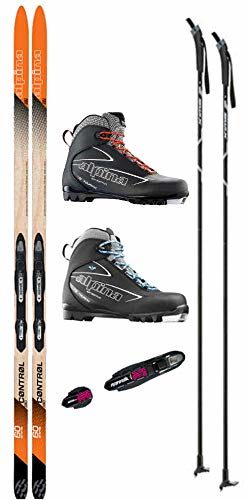
- Stand Out Features - Why We Love It
- Comes with bindings, boots, and ski poles
- Perfect for cross-country skiing
- Reliable on both groomed and ungroomed snow
- Early rise tip improves floating
- Light Air Core significantly reduces weight
- Very enjoyable for beginners
Length: 170, 180, 190, 200cm
Width (Tip/Waist/Tail): 60/50/55mm
Profile: Nordic Rocker Camber
Weight: 10 to 12lbs (skis, bindings, and poles)
Bindings: Yes, Rottefella Auto Tour Classic Binding (NNN bindings)
Core: Lite Air core
Skill Level: Beginner to Advanced Intermediate
Type: Cross-country
BEST VALUE
Atomic Vantage X 74
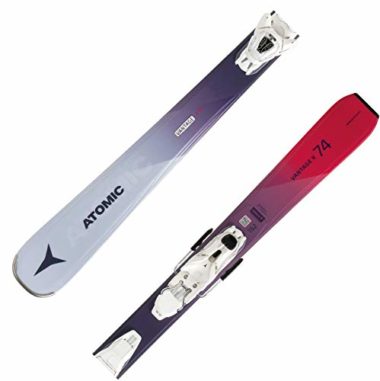
- Stand Out Features - Why We Love It
- Absorbs shocks and bumps well
- Excellent edge grip on groomed snow
- Cap sidewall construction
- Great for building confidence on the snow
- Rocker profile for a better float
- Lightweight foam core and carbon-fiber mesh
Length: 140, 146, 152, 158cm
Width (Tip/Waist/Tail): 120/74/98mm (@152cm length)
Profile: Rocker
Sidecut Radius: 13.2m @ 152cm
Bindings: Yes, Lithium 10 bindings
Core: Densolite Composite core
Skill Level: Beginner to Intermediate
Type: All-mountain
How To Choose Women’s Skis – Buying Guide
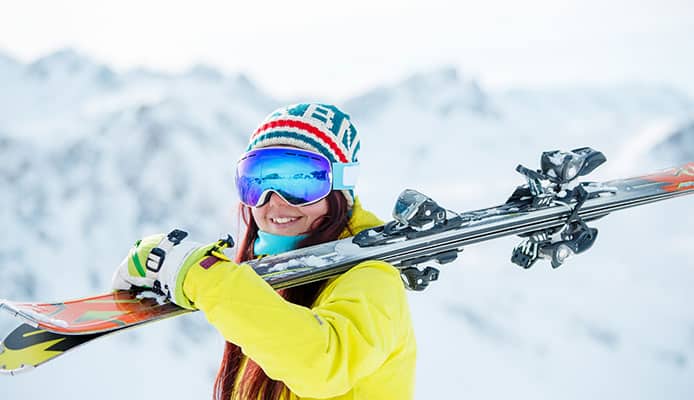
Ski manufacturing has advanced significantly over the years, resulting in plenty of models that are truly designed for women (not just a softer version of men’s skis). Female skiers are, on average, shorter, weigh less, have smaller feet, and a lower center of gravity. When buying a ski, all of these factors need to be taken into consideration.
A women’s ski aims to adapt to these differences. Regardless of the type of skiing you’ll take part in, choosing a pair of skis that are designed for your body (instead of a unisex model) can really make a difference. Take a look.
Length
Because women are usually shorter than men, women’s ski models also tend to be shorter. Still, they do come in many different lengths, and choosing the right one depends on your height, skill level, and the type of skiing. It’s said that the length should be similar to your height so that the tip of the ski reaches somewhere between your chin and head top when the tail is planted in the snow. However, there can be some exceptions to this rule.
Generally speaking, shorter skis are easier to carve and control, but they are slower. On the other hand, longer skis will usually go faster, but beginners might have problems controlling them. You should go with a shorter ski if you’re a beginner or want to improve your technique. A shorter ski might also be a good choice if you’re lightweight for your height or you prefer making quick turns. A longer ski (relative to your height) is a good choice if you’re an advanced skier who wants more speed or needs a reliable off-piste ski.
Width
The width of the ski dictates its performance in many ways. Compared to standard unisex skis, women’s skis are narrower. Because women weigh less, they don’t require the ski to give them as much float on the snow, which allows for the ski waist to be reduced. Also, women have smaller feet, so a narrower ski allows them to get from edge to edge much easier when carving.
When you look at the width of a particular ski, you’ll see the measurements in three areas – at the tip, the waist, and the tail. Waist width is the most important because it determines how you catch an edge when turning and carving. Narrower skis (85 to 95mm) are better for carving groomed snow on the piste, while wider (110+mm) skis are better for deep powdery snow because they give a better float and stability in crud.
Women’s all mountain skis (95 to 110mm) are a jack of all trades, able to conquer corduroy, crud, ice, and deeper ungroomed snow. We also want to add that a wider ski tip helps improve float and makes turns easier, while a wider tail gives better stability in faster turns.
Weight
Even though weight is not a crucial factor for women’s skis (as people thought earlier), it’s true that female skis have a lighter construction. Women weigh less than men, so a lighter ski allows you to control it better in most situations. Also, a lighter ski exerts less pressure on your legs and joints when turning, and you’ll have an easier time carrying them when you take them off.
On the other hand, heavier skis stay on the snow better and have a better grip. They also have less bounce when you’re going through crud and bumps, but require more strength to turn. In light of this, considering the weight of your skis before buying might help save you some energy when you hit the snow.
Stability and Speed
Stability on the snow is very important, especially for beginners who have not yet mastered the proper technique. As we’ve pointed out earlier, wider skis cover a larger surface on the snow, which results in better stability. It’s also very important that the ski stays stable when making turns, otherwise you’ll have a rough ride. This has to do with the flex of the ski, which we’ll cover in the next section.
Because beginner skis are not really fast (no matter if they are men’s or women’s model), you might be one of the skiers who look for a faster ride on the snow. In that case, the Blizzard Black Pearl 88 might live up to your expectations – it’s one of the best all mountain skis for women who seek a bit more excitement on the slopes. In addition to length, the construction of the ski (base, edges, sidewalls) also influences how fast the ski will be when you’re going downhill.
Stiffness (Flex)
The flex of the ski has a huge impact on the performance you’ll be able to get on the snow. Both soft and firm skis have some advantages and disadvantages. For a long time manufacturers thought that all women’s skis should be soft (they are easier to ride), but many advanced female skiers didn’t like this because it limited their progress and what they could do on the snow.
A soft ski has an excellent ability to absorb bumps and vibrations, which results in a much smoother and more stable ride. It is a great choice for inexperienced skiers because it corrects many beginner mistakes that novices make. This type of ski also gives you more control and requires less energy to maneuver.
On the other hand, some of the best women’s skis for more advanced skiers are pretty stiff. While this does reduce stability to a degree, it also allows you to achieve a significantly higher speed when going downhill. However, many skiers choose to go with something in between. This is why most all-mountain skis have a medium flex, allowing them to stand up to any task you put before them.
Sidecut
As you know, a ski is wider at the tip and the tail and narrower at the waist. This means that the side of the ski isn’t flat, but that it’s curved more or less inwards. This is called a sidecut and it’s done to make turning easier (to allow the skis to make a curve when turning). If the side was flat, it would be pretty difficult to make a proper turn when carving the snow.
In relation to this, the shape of the sidecut dictates the turning radius of the ski (the radius of an imaginary circle the skis would form when turning). Women’s downhill skis that are longer and have a smaller sidecut will have a larger turning radius. Similarly, shorter skis with a larger cut have a smaller radius and turn faster. The turning radius usually measures somewhere between 11 and 20 meters (with some models going above and below these numbers).
Furthermore, this is also related to how responsive a ski is. Inexperienced skiers and those of you who need to make sharp turns should go with skis that have a shorter radius. On the other hand, advanced-level skiers might want to go with a larger turning radius because it allows making wider turns at higher speeds.
Profile
While this isn’t directly related to men’s and women’s skis, the profile of the ski has a lot to do with its performance so you should think about it before buying. When browsing skis, you’ll come across models with a camber, a rocker, and many combinations of these two. You’ll see the profile when you lay the ski flat on the ground (without load) and look at it from the side.
A camber is a middle section that is lifted off the ground when the ski isn’t under any type of load. The lifted surface comes in contact with the ground only when you step on the skis. This is a very effective way of increasing the edge surface when carving the skis. It keeps you in contact with the snow and makes carving much easier and smoother.
A rocker is a ski profile where only the midsection is in contact with the snow and the tip and tail are curved upward (resembles a rocking chair). This style prevents the ski from diving into the snow. It floats much better on the surface, especially in fresh powder snow. On the other hand, it has less edge contact so turning isn’t as easy.
Models that combine the two (like the Black Pearl 88) try to get the best out of both types. If you want to learn more about this, be sure to read our article on the differences between a camber and a rocker.
Materials (Construction)
It goes without saying that high-quality materials are required for any ski, regardless of whether it’s designed as a unisex ski or a women-specific model. With this in mind, there are still some differences in construction when it comes to women snow skis.
Women-specific design often means that the ski has a softer core inside and fewer layers of laminate on top. The smaller amount of materials reduces both the weight and the stiffness of the skis, making them more flexible and easier to control. Other than that, the construction process of the ski is pretty much the same, so you’ll be able to find all the different types of skis in the women’s category too.
Mounting Position and Ramp Angle
We mentioned at the beginning that women have (on average) a lower center of gravity when compared to men. This means that the pressure that a female body creates on the skis isn’t the same. To compensate for this, the best women’s skis have a different mounting position for the ski bindings. This position is usually moved a few centimeters towards the tip, giving you more power in the tip as well as better control and stability.
Some of the women’s ski models come with integrated bindings (these are called system skis). These are already built into the ski, meaning that you don’t have to drill holes for the bindings. This makes the ski more flexible and easier to turn because it doesn’t have a bolted spot in the middle (where it doesn’t flex). An argument against this would be that you can’t choose the mounting position yourself. Still, we feel that having pre-installed bindings is pretty great for women’s skis.
We also want to mention another small difference that female skis have. The ramp angle on the bindings is often tilted forward a bit, so your ski boots don’t sit flat when you lock them in. This additionally helps with the balance and maneuverability on the skis.
Performance
All of the things we’ve discussed above influence the performance. While the best all mountain skis for women are able to tackle most challenges, it would be wise to think about your skill level and the tracks you’ll be skiing before you make your final choice.
For example, if you mainly need a ski for carving, you want a model that is easy to turn edge to edge and that stays in full contact with the surface throughout the turn. This is desirable if you usually ski on groomed tracks in resorts. In addition, this type can be a good choice for those of you learning how to ski.
Narrow skis can also be pretty exciting and playfull to ride. A smaller waist makes the ski more responsive and maneuverable, and it’s even better if they have a good rebound when you twist and turn them. Furthermore, it’s a plus if the ski has the ability to cut through crud and handle bumps without throwing you off.
If you want to try off-piste skiing, you perhaps need a wider ski that can handle powder. A wider tip and waist help the ski float on the snow, while a rocker prevents it from diving into the snow. This will result in a much better performance in these conditions (compared to narrow skis).
Graphics
The print pattern on ladies skis has nothing do to with the performance. While we’re sure you know this, we wanted to point it out so you don’t get tempted to go for the prettiest pair of skis you see. Make sure to consider all of the other factors first, as they are more important for enjoying the ski and your time on the snow.
Luckily, with so many women’s ski models on the market, you can get both. You’ll come across numerous models with colorful and interesting graphics that also offer the performance you would expect.
FAQs
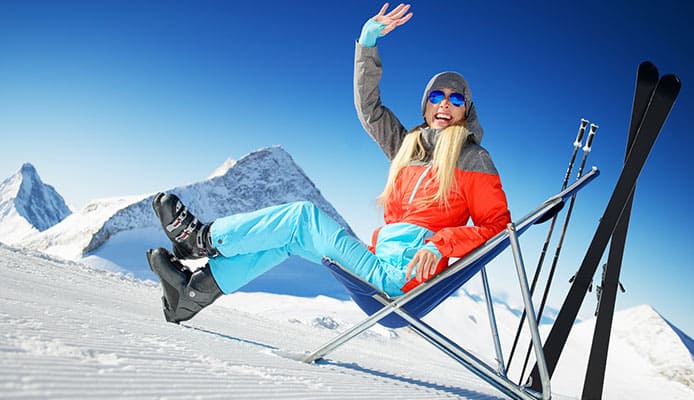
Q: What Is The Difference Between Men’s And Women’s Skis?
The main difference is that women skis are made to be lighter and more flexible, so you have an easier time controlling and maneuvering them efficiently. They also often have a different mounting position that gives you a better balance. If you want to learn more, be sure to read our article about all the differences between men’s and women’s skis.
Q: Do I Really Need Women’s Skis?
In short, no, you don’t need women’s skis. All women can definitely use unisex skis, as people have done for a long time. However, women’s skis will improve your experience on the snow and allow you to have more fun. Just like women can wear any jacket or glove, women’s ski jackets and gloves will be more functional and have a better fit.
Globo Surf Overview
All of us who enjoy skiing want to make every second on the snow count. A new pair of skis raises the bar when it comes to fun and excitement, especially if the skis are tailored just for you. Female skis do exactly this – they are narrower, lighter, and more flexible, allowing you to truly enjoy yourself. They’ll be a great addition to your skiing checklist this season, and we’re absolutely sure you’ll notice the difference.

